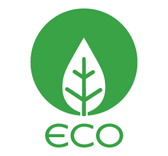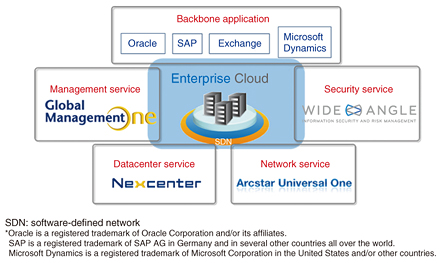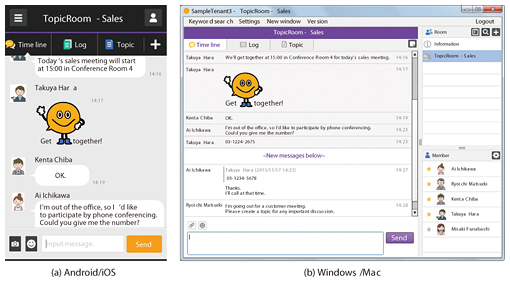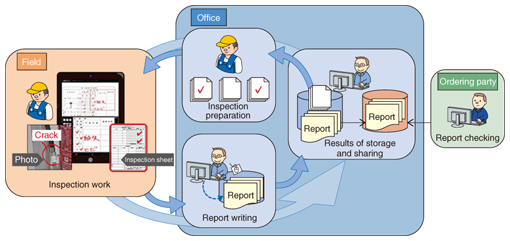 |
|||||||||||||||||||||||
|
|
|||||||||||||||||||||||
|
Global Standardization Activities Vol. 14, No. 9, pp. 28–35, Sept. 2016. https://doi.org/10.53829/ntr201609gls Promotion of Environmental Management According to ITU-T L.1410 in NTT GroupAbstractThe NTT Group is moving forward with environmental management practices conforming to ITU-T (International Telecommunication Union - Telecommunication Standardization Sector) Recommendation L.1410. Here, we describe the promotion of energy-saving technology for datacenters, the evaluation of environmental contributions of products and services developed by NTT laboratories, and the environmental solution label. Keywords: environmental management, ICT, ITU-T L.1410 1. IntroductionTHE GREEN VISION 2020 formulated by the NTT Group in November 2010 promoted three approaches for activities related to three environmental management themes (Fig. 1). The three themes focus on creating a low carbon society, implementing closed-loop recycling, and conserving biodiversity. The three action approaches are efforts to reduce the environmental impact of our own business activities (Green of ICT), the use of information and communication technology (ICT) services to contribute to reducing the environmental impact by society as a whole (Green by ICT), and contributions to various environmental protection activities together with Group employees, their families, and local communities (Green with Team NTT) [1].
More specifically, Green of ICT refers to the efforts by the NTT Group to reduce its own environmental impact by lowering CO2 emissions through increased energy efficiency of ICT equipment and ICT facilities such as networks and datacenters. Green by ICT refers to efforts that contribute to reducing the environmental impact of society as a whole from a broad perspective that encompasses all fields. Those efforts include using ICT to reduce consumption and the need to transport people and goods, increase the efficiency of energy use in the supply chain, and increase the visible impact of ICT use on the environment. Green with Team NTT refers to participation in various activities aimed at protecting the environment by Team NTT, a group whose members support the corporate social responsibility of the NTT Group and employees of the NTT Group in general, together with local communities. Worldwide attention is being placed on the use of ICT to increase energy efficiency and efficiency in the production and consumption of goods as well as the use of ICT to reduce the transportation of people and products. To promote the introduction of ICT, we need ways to quantitatively evaluate the effectiveness of its positive environmental contributions. NTT laboratories are developing methods for calculating the environmental impact of the Green of ICT and Green by ICT approaches. One result of that research is the development of a method for calculating the amount of CO2 emissions over the entire lifecycle of products, networks, and services, which has been adopted as Recommendation L.1410, “Methodology for Environmental Life Cycle Assessments of Information and Communication Technology Goods, Networks and Services” by the International Telecommunication Union - Telecommunication Standardization Sector (ITU-T). Here, we describe efforts within the NTT Group to promote effective environmental management based on that Recommendation. 2. Case study of environmental assessment on energy-efficient technology for datacenters based on ITU-T L.1410Datacenters generally consume about ten times as much power per unit floor area as offices, so a quantitative evaluation of the effect of introducing energy-saving technology can be expected to contribute to a reduction of CO2 emissions as such technology is adopted. NTT laboratories have performed a lifecycle environmental impact assessment based on ITU-T L.1410 with the objective of evaluating the effect of energy-efficient datacenters on the environment. The subject of the study was a datacenter implementing a combination of NTT FACILITIES technology, including a highly efficient air-conditioning system, a high-voltage direct current (HVDC) power supply system, and technology for reusing the heat generated by equipment (Table 1) [2]. The results of the annual operation of servers, air conditioning, and the power supply for a datacenter with a total annual ICT equipment power consumption of 183,585 kWh revealed there was an annual reduction in CO2 emissions of about 40%. This case study was published as a supplement to ITU-T L.1410 [3].
3. Assessment of the environmental contribution of research and development (R&D) productsThe NTT Service Innovation Laboratory Group, NTT Information Network Laboratory Group, and NTT Science and Core Technology Laboratory Group have been engaged in various research projects related to ICT and are striving to reduce the environmental impact of ICT while contributing to ICT development on the basis of THE GREEN VISION 2020 [3]. Since the 2014 fiscal year, the three laboratory groups have been efficiently and effectively operating an integrated environmental management system designed to reduce the environmental impact of ICT use. The laboratory groups have moved forward with creating and providing R&D results that make positive contributions to the environment. The R&D results provided to NTT operating companies make large indirect contributions via customers and society as a whole to reducing the environmental impact of ICT use, thus helping to prevent global warming. In partial accordance with the concept of ITU-T L.1410, we are making progress in clarifying NTT’s contribution to the alleviation of global warming by evaluating the contribution of R&D results, publishing environmental reports, and providing feedback to the R&D process. In the 2014 fiscal year, the results of ten research projects were evaluated, and two that were found to have made large contributions, “edge router systems for next-generation networks—high-capacity routing node for next-generation network transport systems” and “voice mining platform,” were described in Environmental Report 2015 [4]. Here, we describe those results together with their contributions to the environment. 3.1 Edge router systems for next-generation networksThe high-capacity routing node is the core router of the transport system for the next-generation network and will be used in a redundant three-level star configuration. The area edge routers installed in edge node buildings have a higher accommodation ratio for subscriber service edges (SSEs)*1 than previous routers, and the evaluation was performed for the case in which the core routers were equipped with newly developed interface modules. The conventional edge routers and the developed edge routers were compared for the same amount of information processing, and the increase in the SSE accommodation ratio was taken as a quantitative measure of the environmental contribution. In the evaluation, there were 154 SSEs per conventional edge router and 240 SSEs for one developed edge router*2. The systems were set up for redundancy with active equipment (system 0) and backup equipment (system 1) as shown in Fig. 2.
The results show that the developed system accommodating 240 units contributed to a 37% decrease in annual CO2 emissions (195 t CO2/year) relative to the conventional case. The main factor in the decrease is that the increase in the number of SSEs accommodated per edge router reduces the number of required edge routers to one (or two, considering both the active and backup systems). 3.2 Voice mining platformProblems encountered in conventional analysis of calls in call centers include the fact that only a small volume of calls can be analyzed because the calls must be transcribed manually and also that the analysis is subjective and time-consuming. Voice mining technology makes it possible to quickly and flexibly analyze a large volume of calls objectively and quantitatively, which has previously been difficult to achieve. NTT’s voice mining platform records the calls between operators and customers in call centers and uses speech recognition technology to convert the calls to text. Various call analysis techniques that use spoken language processing technology are then performed. This platform can be used to increase efficiency in the process of discovering problems in call center operations and in the products and services offered so that improvement policies can be set [5]. We evaluated the application of this platform in a call center. To quantify the environmental effect, we compared two cases for analysis (Fig. 3). In the first case, the analysis was performed manually after all calls had been obtained. In the second case, the analysis work was partially automated by using the voice mining platform. The call center used for this evaluation had 50 operators, and the analysis was done monthly on all calls, for a total of 12 times in one year. The evaluation conditions were manual transcription of recorded call speech for the conventional case and automatic conversion of the recorded call speech to text followed by partial automation of the analysis task for the case in which the voice mining platform was used.
The evaluation results show that using the voice mining platform for call analysis contributed to reducing CO2 emissions by 98% (257 t CO2/year) compared to the conventional process of analysis. The main factor in the emission reduction is the substantial decrease in manual work achieved through automation of call analysis.
4. NTT Group environmental solution labelThe NTT Group environmental solution labeling system certifies ICT solutions provided by the NTT Group that exceed a specified criterion for reducing the environmental impact (reduction of CO2 emissions) of ICT as environment-friendly solutions [6]. The use of some ICT services contributes to reducing the environmental impact of our society as a whole [7]. In the NTT Group, services that reduce CO2 emissions by 15% or more are certified as environment-friendly solutions and are marked with a label in the service catalog and other places (Fig. 4). Our objective in providing such services is to reduce the environmental impact of the NTT Group, our customers, and society as a whole. We have been evaluating the effect of ICT services on reducing CO2 emissions according to the Environmental Efficiency Assessment Guidelines for ICT Services issued by the Japan Forum on Environmental Efficiency (currently merged with the Life Cycle Assessment Society of Japan) [8]. The article “Assessment of ICT Effects in the Reduction of Environmental Impact,” which is based on those guidelines, appeared in the “Study Group on ICT Policy Concerning Global Warming” report issued by the Ministry of Internal Affairs and Communications of Japan in April 2008. The approach of the assessment methods described in the article were incorporated in ITU-T L.1410.
Here, we present and explain the assessment results for three solutions that are likely to have relatively high environmental impact reduction effects from among the solutions that were certified in 2015 and 2016. 4.1 Enterprise Cloud from NTT CommunicationsEnterprise Cloud is a global cloud service that takes advantage of NTT Group’s strong technical capabilities and abundant expertise concerning networks, datacenters, applications, and security as a telecom carrier (Fig. 5). Enterprise Cloud makes it possible to reduce CO2 emissions by providing for virtualization of servers and storage. The assessment conditions involved an enterprise with four offices and 300 employees that operates and manages ICT storage facilities with a capacity of 6900 GB over a period of one year. The assessment revealed that use of the system reduced CO2 emissions by 74% relative to a conventional system.
4.2 TopicRoom from NTT SoftwareTopicRoom is a chat tool for fast, secure, and simple sharing of business information. It can be used on desktop computers, tablet devices, and smartphones, so work efficiency can be increased by sending a message on an issue to be discussed to TopicRoom from any device so that the issue can be resolved quickly (Fig. 6) [9]. Use of TopicRoom can be expected to reduce the time and movement of people to attend meetings as well as the use of paper.
Under the assessment conditions of 48 meetings involving a total of five people from five offices (Shinagawa, Ogikubo, Yokohama, Nagoya, and Osaka) over a period of one year, the use of TopicRoom reduced CO2 emissions by 78% relative to the conventional process (where employees traveled to attend meetings). 4.3 BizInspect® from NTT DATA ShikokuBizInspect® is a solution in which a tablet device is used to check inspection items, enter results, and automatically generate and save reports during the inspection, testing, investigation, or repair of buildings and other facilities (Fig. 7). When performed in the conventional way, this task involves carrying a large amount of paper materials and requires a lot of time to compile reports with photographs of the inspection site. Using BizInspect reduces the amount of materials needed and makes the work more efficient. For periodic inspections and other such tasks that are performed repeatedly, inspectors can check the previous inspection results, so it is possible to perform the inspection efficiently while maintaining the inspection information obtained up to the previous inspection. With paperless inspection materials and reports, the natural resources consumed for paper can be reduced, and the storage space required for paper materials can also be eliminated. Another advantage is that the input of information is not duplicated in the on-site inspection work or in the report production work that is done in the office, so less time is required to complete the task.
BizInspect was assessed in conditions involving four inspections and the production of reports for them at 900 locations over a one-year period, and the results revealed that the use of BizInspect resulted in a 68% reduction in CO2 emissions relative to the conventional process. 5. Future challengesThe NTT Group will continue to develop environment-friendly solutions and to promote the social contribution and environmental impact reduction effect of ICT in ITU-T well into the future. References
|
|||||||||||||||||||||||










